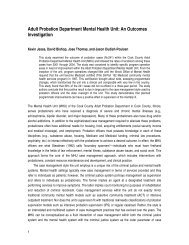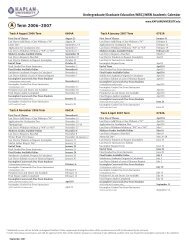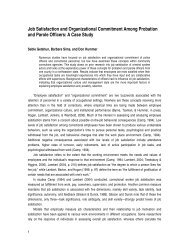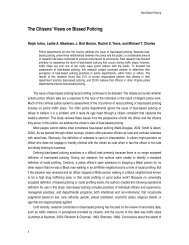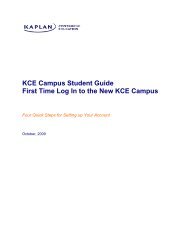Police Officer - Kaplan University | KU Campus
Police Officer - Kaplan University | KU Campus
Police Officer - Kaplan University | KU Campus
You also want an ePaper? Increase the reach of your titles
YUMPU automatically turns print PDFs into web optimized ePapers that Google loves.
<strong>Police</strong> <strong>Officer</strong> Recruitment<br />
The typical police officer today is better educated, better trained, and more<br />
representative of the community the departments serve. Educational levels have risen,<br />
training programs have improved, and there are more African-American, Hispanic, and<br />
women police officers today than at any time in the past (Walker, 1999). A review of the<br />
current print media advertisement, the collective bargaining agreement, and the<br />
departmental hiring standards of the participating agency was conducted to identify areas<br />
that the researcher believed may be attractive to or detrimental to potential candidates<br />
within this changing police officer demographic.<br />
The research questions are:<br />
1. Is applicant attraction to and likelihood of pursuing the job of police<br />
officer influenced by a city residency requirement?<br />
2. Is applicant attraction to and likelihood of pursuing the job of police<br />
officer influenced by specialization opportunities?<br />
3. Is applicant attraction to and likelihood of pursuing the job of police<br />
officer influenced by an educational reimbursement policy?<br />
Results<br />
This study had an experimental design involving a 2 x 2 x 2 completely crossed fixedfactor<br />
factorial ANOVA (Kirk, 1995). The study participants were working police officers<br />
who took part in a recruitment simulation.<br />
To implement the data collection, the researcher attended inservice training to collect<br />
data at a police agency located in a major metropolitan area in the Midwest. The data<br />
collection effort resulted in responses from 277 study participants. Analysis of the data<br />
proceeded in three stages: (a) descriptive statistics, (b) reliability analysis, and (c)<br />
inferential analysis.<br />
Descriptive Statistics<br />
Descriptive statistics for study participants appear in Table 1. The mean age of the<br />
participants was 36 years. The mean number of dependent children was 1.2. A majority of<br />
the participants were male (76.5%), White (62.8%), and married (57.8%). The distribution<br />
for highest degree earned was: high school diploma (12.3%), associate’s degree (16.6%),<br />
some college (36.8%), bachelor’s degree (31.0%), and other (3.2%). The majority of the<br />
participants were patrol officers (70.8%) and had either 0 to 5 years experience (39.7%)<br />
or 6 to 10 years experience (28.2%). A majority of the participants worked the day shift<br />
(60.0%) and were assigned to the patrol division (94.9%).<br />
Professional Issues in Criminal Justice Vol 4(3 & 4), 2009 73



